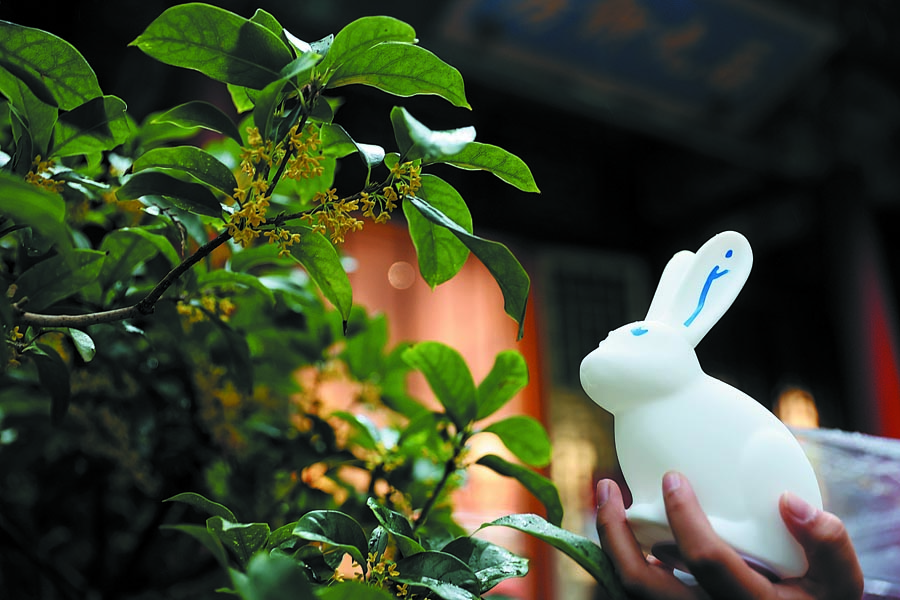中国日报网 2023-11-07 17:02:56
From drinks and desserts to tourist sites, sweet osmanthus has been an autumn favorite for Chinese people for over 2,000 years

In many countries, the return of Pumpkin Spice Lattes to Starbucks menus has become an unofficial harbinger of the fall season. But in China, especially for people who live in southern parts of the country, it's not pumpkin but sweet osmanthus flowers (or guihua ) that best represent the season of falling leaves.
Guihua , which typically blooms in September or October, is officially known as 木犀 (mù xī, literally "wooden rhinoceros") in Chinese, owing to the resemblance between the tree's texture and rhinoceros horns. The plant is prominent in southern China and in provinces along or south of the Yangtze River.
Its small but thick flowers, which come in various colors including white, yellow, and red, are so pungent that they can supposedly be smelt miles away. The flowers have even been dubbed 九里香 (jiǔ lǐ xiāng, "nine li [equivalent to 4.5 kilometers] fragrance)."
Just like pumpkin, guihua has also been incorporated into food and drinks across the country in recent years. Goodme, a major tea brand in China, launched its sweet osmanthus-flavored series of milk tea in October last year. It became an instant hit, selling over 100,000 cups in just five days in Hangzhou, Zhejiang province, which hosts around 300 of the chain's more than 9,000 stores nationwide.
This year, long before autumn, many netizens were already making posts pressing the brand to bring back their limited-time guihua drink again. When the drink finally dropped this September, over 1.3 million cups were sold within two days nationwide.
Independent shops are in on the act too. One coffee store owner in Changsha, Hunan province, told local media Changsha Evening News that they sold 50 to 100 cups of their seasonal sweet osmanthus-flavored coffee each day last October. On the food delivery platform Meituan, searches for the keyword "sweet osmanthus" and related products like osmanthus cake, fermented glutinous rice with osmanthus, and osmanthus mango pudding, increased up to 16 times between September and October last year.
However, Chinese people's fascination with guihua is not a recent phenomenon. The earliest record of guihua can be found in The Classic of Mountains and Seas (《山海经》, shān hǎi jīng), a mythological book believed to be compiled in the fourth or third centuries BCE. In Master Lü's Spring and Autumn Annals (《吕氏春秋》, lǚ shì chūn qiū), a book written by the Qin dynasty (221 – 206 BCE) prime minister Lü Buwei (吕不韦. lǚ bù wéi) and his hangers-on, the flower was described as "the [most] wonderful thing."
The plant was originally reserved for the royal family and nobility, but during the Tang (618 – 907) and Song (960 – 1279) dynasties, it gradually became popular among literati and common people. "Osmanthus fall during the Mid-Autumn Festival period, their celestial fragrance drifts beyond the clouds," wrote Tang dynasty poet Song Zhiwen (宋之问, sòng zhī wèn) in his work "Lingyin Temple (《灵隐寺》, líng yǐn sì)."
Literatus Yang Wanli (杨万里, yáng wàn lǐ ) from the Song dynasty also praised the flower's heavenly scent in his poem "Ode to Osmanthus (《咏桂》, yǒng guì)": "It's not grown on the earth, but transplanted from the moon; its fragrance awakes the whole mountain to full blossom."
Nowadays, during fall, thousands of people still rush to scenic spots like Shaoxing of Zhejiang, Wuhu of Anhui province, and Xianning of Hubei province to see osmanthus trees, some hundreds or even thousands of years old, and enjoy the flower's refreshing scent.
According to a 2022 report on China's perfume market by the consultancy iiMedia Research, the fragrance of osmanthus is the most popular perfume scent, capturing the hearts of 44.7 percent of the surveyed consumers. It is followed by rose (36.7 percent), jasmine (35.4 percent), and lavender (34.3 percent).
Besides the fragrance, many people's fondness for sweet osmanthus derives from flower-themed food and drinks. Guihua has been eaten for nearly as long as its emergence is recorded. Osmanthus-flavored wine can be traced back to the fourth and third centuries BCE when it was referred to as "osmanthus liquid (桂浆, guì jiāng)" in the poem "Nine Songs (《九歌》, jiǔ gē)" by the renowned scholar Qu Yuan (屈原, qū yuán).
The "Guanghan cake" made with osmanthus and rice powder in the recipe book Simple Foods of the Mountain Folk (《山家清供》,shān jiā qīng gòng) by Lin Hong (林洪, lín hóng) from the Southern Song dynasty (1127 – 1279) is believed to have been similar to the modern osmanthus cake. There are also popular osmanthus-flavored tea, such as osmanthus Longjing tea from Hangzhou and osmanthus Oolong tea from Anxi, Fujian province, and dishes like lotus root with sticky rice and osmanthus from the Jiangnan region south of the Yangtze River.
The autumnal flower has become so popular today that Chinese media even coined the term "sweet osmanthus economy," which refers to associated sectors, from food to tourism, collectively. "Last year, our 'Sweet Osmanthus Festival' attracted over 80,000 visitors and generated revenue of more than 7 million yuan," an official from Andi, Zhejiang, told the local newspaper Jinhua Daily this October. With a population of around 17,000 people, the small town has grown around 10,000 mu (approximately 667 hectares) of osmanthus trees and hosted the annual three-day festival for 15 years. The celebrations include tours of Andi's Xianyuan Lake Resort, cultural performances, and osmanthus-themed products.
The flower even featured heavily in the 19th Asian Games in Hangzhou, a city with around 5 million osmanthus trees of more than 200 varieties. The scent of osmanthus pervaded the Hangzhou Olympic Sports Center during the opening ceremony on September 23, as hundreds of college students marched in the venue holding sweet osmanthus bunches. The flower was also a part of bouquets presented to medal winners.
Unfortunately, the scent of fresh osmanthus and the feeling of autumn usually last no longer than a month in China. So if you want to take a bite of some osmanthus-flavored food and get a taste of autumn, now is the time.
责编:田梦瑶
一审:田梦瑶
二审:秦慧英
三审:黄晓辉
来源:中国日报网
我要问



 下载APP
下载APP 报料
报料 关于
关于
 湘公网安备 43010502000374号
湘公网安备 43010502000374号